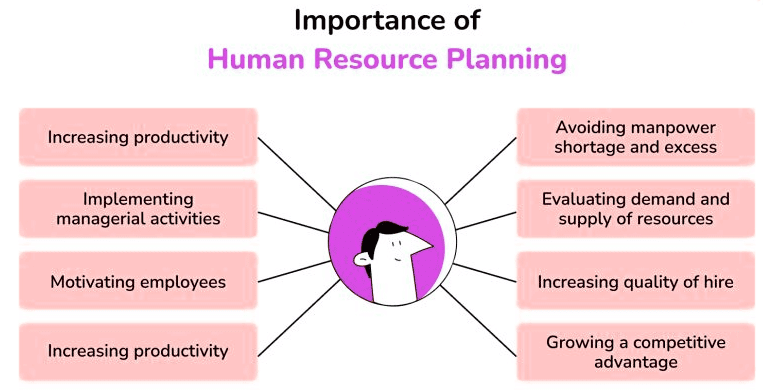Human Resource Planning | Crash Course for UGC NET Commerce PDF Download
Understanding Human Resource Planning (HRP)

Human resource planning (HRP) is a vital ongoing process that involves systematic planning to ensure the optimal utilization of an organization's most valuable asset—its workforce. The primary goal of HRP is to align the capabilities and availability of employees with the organizational needs, thereby avoiding situations of either understaffing or overstaffing.
Key Aspects of Human Resource Planning:
- HRP involves analyzing the current labor supply within the organization to understand the existing workforce.
- Forecasting labor demand is another crucial step, which entails predicting the future requirements of the workforce based on business goals and industry trends.
- It is essential to strike a balance between projected labor demand and the available supply to ensure efficient operations.
- HRP plays a pivotal role in supporting the overarching goals and objectives of the organization, contributing to its productivity and profitability.
What is Human Resource Planning (HRP) Used For?
Employees are crucial to any business's success. Without a capable workforce, revenue may decline, potentially leading to business failure. Human Resource Planning (HRP) helps prevent this by identifying current and future hiring and training needs. It ensures companies can maintain a steady supply of skilled employees by evaluating their needs and planning accordingly.
HRP must be adaptable to address both short-term staffing issues and long-term business environment changes. HR managers use HRP to:
- Find and attract skilled employees
- Select, train, and reward top candidates
- Keep employees motivated
- Manage absences and conflicts
- Plan for succession
- Promote or terminate employees as needed
- Monitor trends that could impact future supply and demand
By identifying and targeting the necessary skills, companies can strategically reach their goals and be prepared for future challenges.
Goal of Human Resource Planning (HRP)
The main goal of HRP is to have the optimal number of staff to maximize profitability. Effective HRP helps companies:
- Enhance the value of current employees
- Gain a competitive edge in their industry
- Adapt to challenges and changes more effectively
Challenges of Human Resource Planning (HRP)
While HRP offers numerous benefits, it also presents challenges. Predicting the future is difficult, and unforeseen events like technological breakthroughs or employee poaching can disrupt plans. Globalization and remote work also introduce complexities, requiring HR departments to adapt to varying labor regulations and new recruitment methods.
To overcome these challenges, companies need to be flexible and continuously monitor their environment. Preparedness allows them to handle and potentially capitalize on impactful events. Regular updates to HRP strategies are essential to align with the company's evolving needs and external changes. HRP can be time-consuming and costly initially but is crucial for long-term success.
Four Steps of Human Resource Planning (HRP)
Analyzing Labor Supply: Identify the current workforce's composition, including the number of employees, their skills, qualifications, positions, benefits, and performance.
Forecasting Labor Demand: Project future workforce needs by considering factors like promotions, retirements, layoffs, and external conditions such as technological changes.
Balancing Labor Demand with Supply: Conduct a gap analysis to compare current labor supply with future demand. This analysis will address questions like whether employees need new skills or if more managers are required.
Developing and Implementing a Plan: Use insights from the gap analysis to develop and execute a plan, ensuring it aligns with the company's budget and departmental collaboration.
Importance of Human Resource Planning (HRP)
HRP helps businesses maintain and attract the right talent, ensuring employees possess the necessary technical and soft skills. It also supports better training and skill development.
Hard vs. Soft Human Resource Planning
- Hard HRP: Focuses on quantitative metrics to ensure the right number of employees with the required skills are available when needed.
- Soft HRP: Emphasizes finding employees who fit the corporate culture and have the right motivation and attitude.
Both approaches are often used together.
Basic Steps in HRP
HRP starts with analyzing the available labor pool, then evaluates the firm's current and future labor needs, and aims to align demand with the supply of job applicants.
Conclusion
Quality employees are a business's greatest asset. HRP involves creating strategies to ensure an adequate workforce to meet needs, avoiding both surpluses and shortages of workers.
|
157 videos|236 docs|166 tests
|
FAQs on Human Resource Planning - Crash Course for UGC NET Commerce
| 1. What is Human Resource Planning? |  |
| 2. Why is Human Resource Planning important for organizations? |  |
| 3. What are the key components of Human Resource Planning? |  |
| 4. How does Human Resource Planning benefit employees? |  |
| 5. How can organizations effectively implement Human Resource Planning? |  |
















